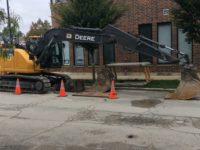The amount of federal economic-stimulus work continues to grow, with the April 15 announcements that the Interior Dept.’s Bureau of Reclamation has committed $1 billion to projects throughout the West and that the Environmental Protection Agency is dividing $600 million among Superfund projects at 50 sites.

BuRec included about 30 large projects and an unspecified number of smaller ones that it plans to finance through the stimulus, the title of which is the American Recovery and Reinvestment Act (ARRA). California will receive the largest share at $260 million. Interior Secretary Ken Salazar says California’s projects will expand water supplies, repair aging infrastructure and attempt to mitigate drought effects. Salazar says an additional $135 million is available for water reuse and recycling projects in the state.
California also has BuRec’s largest single stimulus project, a $109.8-million screened pumping plant at the Red Bluff Diversion Dam on the Sacramento River. The new plant would give endangered salmon and green sturgeon species unrestricted passage upstream and downstream.
BuRec’s Great Plains Region will get $234.5 million, including $59 million for water treatment plants, an intake structure and storage facilities at the Garrison Diversion Unit in North Dakota, as well as $56.5 million to accelerate construction of a water-treatment plant near Vermillion, S.D.
The Pacific Northwest Region will receive $125.2 million, including $50 million to build a siphon complex near Moses Lake, Wash. The allocation for the Lower Colorado Region is $107.9 million, Upper Colorado Region $28.3 million and the Central Utah Project $50 million.
The bureau does not have a timetable yet for getting the stimulus projects under contract, says spokesman Kip White. He says BuRec will measure projects against several criteria, including how shovel-ready they are as the agency moves into the contracting stage. White says the stimulus contracts will be managed by BuRec’s five regions and the Central Utah Project office. “That is the way all of our contracting is done,” he adds.
| MID-PACIFIC REGION | 260.0 |
|---|---|
| Red Bluff Diversion Dam, Calif. (screened pumping plant) | 109.8 |
| Battle Creek, Calif. (salmon/steelhead restoration plan) | 26.0 |
| GREAT PLAINS REGION | 234.5 |
| Garrison Diversion Unit, N.D. (water-treatment plants, intake structure, storage facilities) | 59.0 |
| Lewis and Clark rural water system, S.D., Minn., Iowa (accelerate water-treatment-plant construction) | 56.5 |
| Fort Peck/Dry Prairie project, Mont. (finish water-treatment plant, water-supply lines | 40.0 |
| LOWER COLORADO REGION | 107.9 |
| Pima-Maricopa irrigation project, Ariz. (canal mileage and check structures) | 36.8 |
| Yuma area, Ariz. (repair, replace water-management and -delivery facilities) | 36.25 |
| PACIFIC NORTHWEST REGION | 125.2 |
| Weber siphon complex, Wash. | 50.0 |
| CENTRAL UTAH PROJECT | 50.0 |
| Utah lake-system pipelines | 41.0 |
| UPPER COLORADO REGION | 28.3 |
| Animas-La Plata, Colo., N.M. (Navajo Nation pipeline, other projects) | 12.1 |
| SOURCES: BUREAU OF RECLAMATION | |
EPA says its Superfund stimulus funds will speed hazardous-waste cleanup already under way and fund new projects. It plans to use the aid on National Priorities List sites, primarily on existing contracts. New Jersey has eight sites on the stimulus list, the most of any state. More than $25 million per location will go to sites in New Bedford Harbor, Mass.; Camden/Gloucester, N.J.; Florence Township, N.J.; South Plainfield, N.J.; Ottawa County, Okla.; Omaha, Neb.; and Eureka, Utah.
One of the first beneficiaries will be the Iron Mountain Mine site near Redding, Calif., set to receive $10 million to $25 million. The money is expected to cut the time needed to dredge, treat and dispose of sediment in the Keswick Reservoir’s Spring Creek Arm from three years to 18 months. The stimulus also will help finance pipelines and pump stations to move contaminated sediment from the Spring Creek Arm to a disposal cell, construction of which will begin in May.
The project has been divided into four packages. Three covering the pumping station, pipeline and treatment plant already have been put out for bid. Within the next two months, EPA expects to bid the final package, for dredging, says Rick Sugarek, EPA’s project manager.
Factors EPA considered in selecting the ARRA-funded sites include readiness, human and ecological risk and opportunities to trim costs and schedules.



